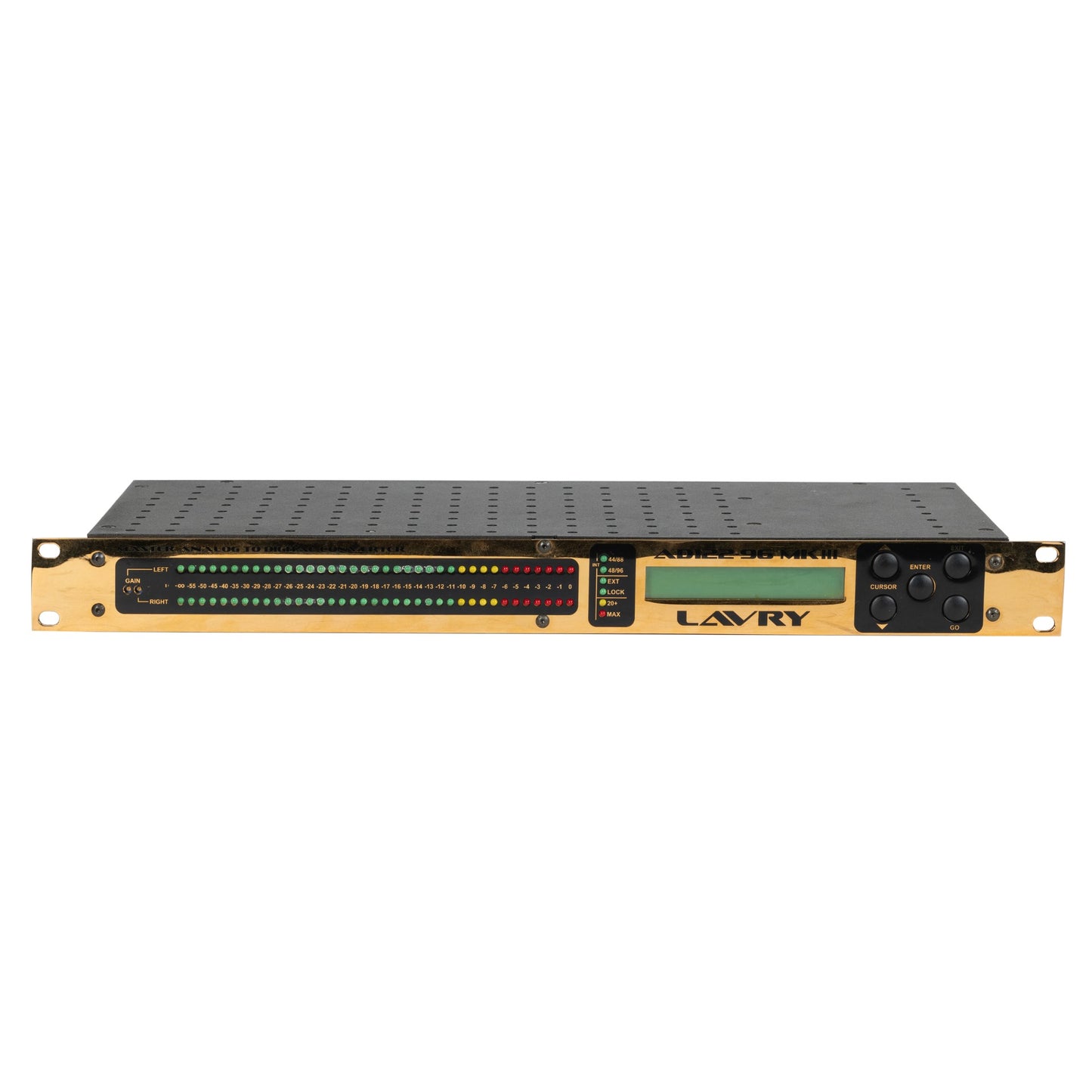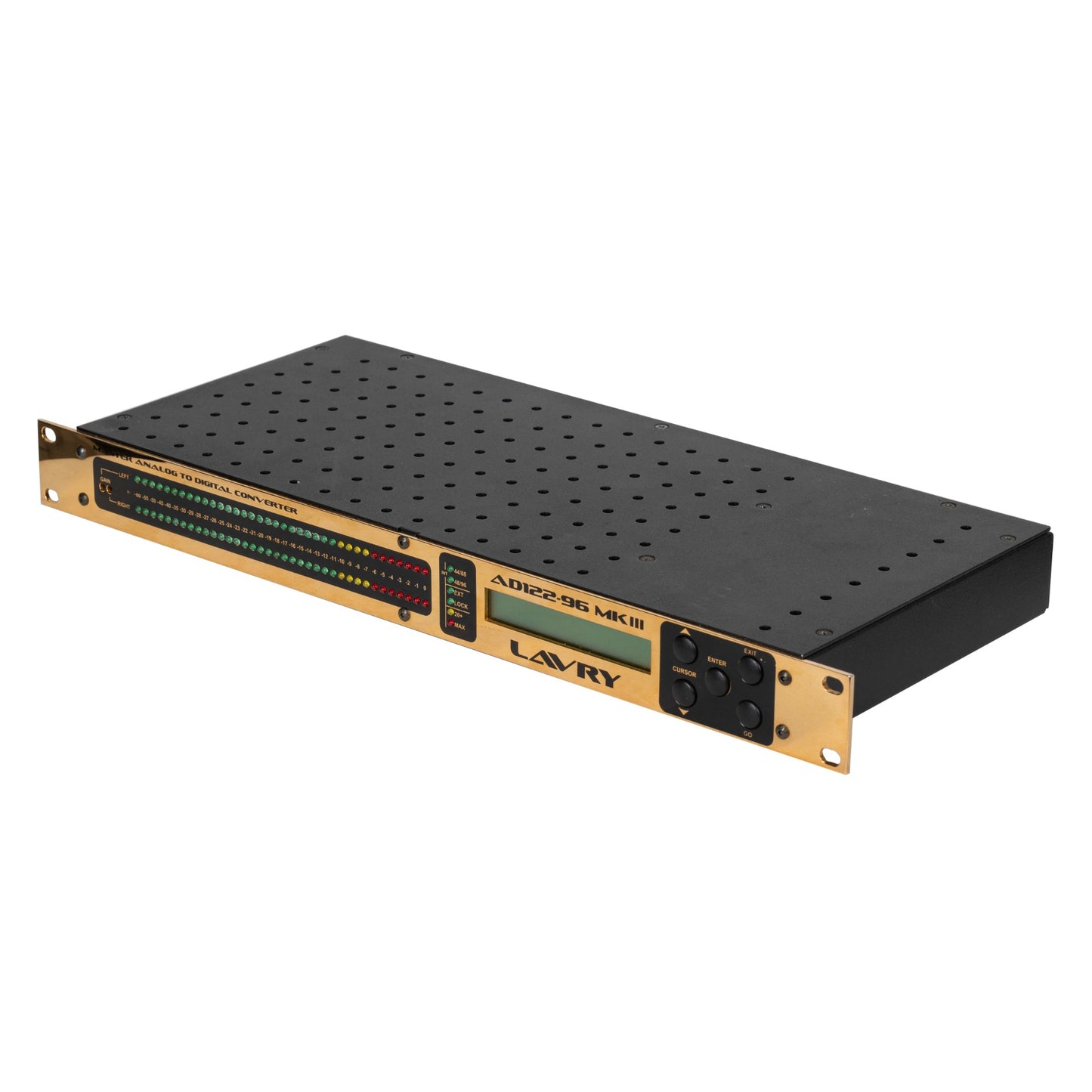



- Details
- Features
- Reviews
*Please note -- this item is pre-owned and may show signs of use. Please see photos.
The Lavry AD122-96MKIII converts analog signals to a true 24-bit digital audio data stream. Consistently used for many of today's top recordings, the AD122-96MKIII features -127 dB dynamic range (unweighted), providing optimum musical results.
Achieving 20 or more bits of resolution places a heavy demand on the linearity and noise of analog signals prior to the A/D conversion.
Linearity
Linearity problems (typically associated with larger signals) should be avoided to prevent overall signal distortions. Proper circuit design places non-linear devices inside a negative feedback path, thus allowing the transfer function to depend on a few linear components (such as resistor ratio). Closer examination reveals that the effectiveness of negative feedback is limited by the open loop gain of the amplifier (the available gain prior to the feedback action). Constructing a 10 dB gain stage out of, say, a 50 dB open loop amplifier provides 40 dB of feedback; thus circuit nonlinearities are corrected for by a factor of 100. A 1% nonlinearity reduces to a .01% level. The same stage, when set to a gain of 20 dB, yields only 50-20=30 dB of "linearizing power"; thus the same 1% circuit nonlinearity is corrected to 1/31.6 = .03%. The "obvious" solution of increasing circuit open loop gain is riddled with problems ranging from impulse response settling time to loss of bandwidth.
Noise
The quantization (A/D conversion) of analog noise causes loss of fine signal detail. The quantized noise introduces time varying signal dependent distortions. Such sample by sample deviation can not be compared to the seemingly "constant" analog background noise. The interaction between the noise and the quantization process effects the sonic detail at much higher amplitude than the noise level itself. The source material may have its own noise level, but the A/D manufacturer is in no position to decide which part of the material is signal and which part is noise. (Is it undesirable noise or is it the intentional recording of the wind blowing through the trees?) Thus, any signal must be reproduced accurately. All we can do, and all we should do amounts to avoiding additional A/D noise. A/D noise consists of two parts: analog noise (prior to quantization), and quantization noise. The quantization noise level is "fixed" by the converter itself. Model AD122-96 MKIII quantization noise relative full scale is about 122 dBFS. Keeping complete system noise level at 122 dBFS requires careful treatment of the analog path. Each circuit component (especially resistors and semiconductors) generates its own noise. The complex electron motion within the various materials adds up to a cumulative noise. Intentional amplification of signals yields undesirable amplification of noise. Once again, each dB of added gain takes away a dB from the available dynamic range.
AD122-96 MKIII Input Range
You may suspect by now that our aim is to provide you with an A/D converter and leave the problem of providing a "hot" signal at the hands of microphone and mic- preamplifier manufacturers. Like many A/D's, Model AD122-96 MKIII provides limited gain (0-11.5 dB).
| Product Name | Lavry AD122 96-MKIII AD Converter |
|---|---|
| Brand | Lavry |
| Condition | preowned |
| MPN | AD122 |
| Shipping Option | Free Shipping to the Continental U.S. |
What's in the Box?
- Lavry AD122 96-MKIII AD Converter
- 96, 88.2, 48 and 44.1 kHz conversion frequencies
- Unequalied detail and performance
- True -127 dB noise floor
- 0.00005% total harmonic distortion + noise
- Conversion to 24-bit
- Built-in acoustic bit correction re-dithering to 16-20 bit formats
- Switchable digital soft-knee limiter, +3 or +6 dB gain
- Precision reference meter bridge
- Fully programmable digital test tones for system alignment
- AES and word clock external synchronization 40-51, 88.2, 96 kHz
- DC removal
- Absolute polarity inversion
- Multi-converter synchronization
Lavry AD122 96-MKIII AD Converter
*Please note -- this item is pre-owned and may show signs of use. Please see photos.
The Lavry AD122-96MKIII converts analog signals to a true 24-bit digital audio data stream. Consistently used for many of today's top recordings, the AD122-96MKIII features -127 dB dynamic range (unweighted), providing optimum musical results.
Achieving 20 or more bits of resolution places a heavy demand on the linearity and noise of analog signals prior to the A/D conversion.
Linearity
Linearity problems (typically associated with larger signals) should be avoided to prevent overall signal distortions. Proper circuit design places non-linear devices inside a negative feedback path, thus allowing the transfer function to depend on a few linear components (such as resistor ratio). Closer examination reveals that the effectiveness of negative feedback is limited by the open loop gain of the amplifier (the available gain prior to the feedback action). Constructing a 10 dB gain stage out of, say, a 50 dB open loop amplifier provides 40 dB of feedback; thus circuit nonlinearities are corrected for by a factor of 100. A 1% nonlinearity reduces to a .01% level. The same stage, when set to a gain of 20 dB, yields only 50-20=30 dB of "linearizing power"; thus the same 1% circuit nonlinearity is corrected to 1/31.6 = .03%. The "obvious" solution of increasing circuit open loop gain is riddled with problems ranging from impulse response settling time to loss of bandwidth.
Noise
The quantization (A/D conversion) of analog noise causes loss of fine signal detail. The quantized noise introduces time varying signal dependent distortions. Such sample by sample deviation can not be compared to the seemingly "constant" analog background noise. The interaction between the noise and the quantization process effects the sonic detail at much higher amplitude than the noise level itself. The source material may have its own noise level, but the A/D manufacturer is in no position to decide which part of the material is signal and which part is noise. (Is it undesirable noise or is it the intentional recording of the wind blowing through the trees?) Thus, any signal must be reproduced accurately. All we can do, and all we should do amounts to avoiding additional A/D noise. A/D noise consists of two parts: analog noise (prior to quantization), and quantization noise. The quantization noise level is "fixed" by the converter itself. Model AD122-96 MKIII quantization noise relative full scale is about 122 dBFS. Keeping complete system noise level at 122 dBFS requires careful treatment of the analog path. Each circuit component (especially resistors and semiconductors) generates its own noise. The complex electron motion within the various materials adds up to a cumulative noise. Intentional amplification of signals yields undesirable amplification of noise. Once again, each dB of added gain takes away a dB from the available dynamic range.
AD122-96 MKIII Input Range
You may suspect by now that our aim is to provide you with an A/D converter and leave the problem of providing a "hot" signal at the hands of microphone and mic- preamplifier manufacturers. Like many A/D's, Model AD122-96 MKIII provides limited gain (0-11.5 dB).
| Product Name | Lavry AD122 96-MKIII AD Converter |
|---|---|
| Brand | Lavry |
| Condition | preowned |
| MPN | AD122 |
| Shipping Option | Free Shipping to the Continental U.S. |
What's in the Box?
- Lavry AD122 96-MKIII AD Converter
- 96, 88.2, 48 and 44.1 kHz conversion frequencies
- Unequalied detail and performance
- True -127 dB noise floor
- 0.00005% total harmonic distortion + noise
- Conversion to 24-bit
- Built-in acoustic bit correction re-dithering to 16-20 bit formats
- Switchable digital soft-knee limiter, +3 or +6 dB gain
- Precision reference meter bridge
- Fully programmable digital test tones for system alignment
- AES and word clock external synchronization 40-51, 88.2, 96 kHz
- DC removal
- Absolute polarity inversion
- Multi-converter synchronization
- Choosing a selection results in a full page refresh.
- Opens in a new window.




